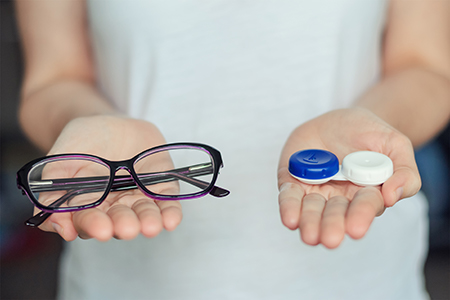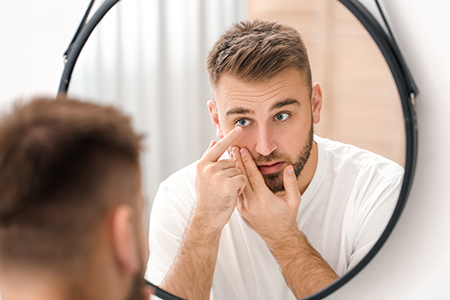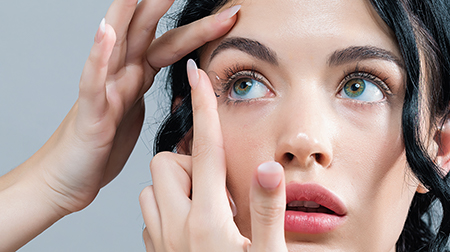
Contact lenses today deliver a level of comfort and flexibility that was once unimaginable. Advances in lens materials, oxygen permeability, and surface treatments mean lenses can be worn for a wider range of activities and for longer, healthier periods. Whether you’re seeking a daily, disposable option or a specialty lens for irregular corneas, modern contacts are engineered to work with your eyes and your lifestyle.
At Vision World of Copiague, we approach contact lens care as a blend of precise measurement and practical guidance. A successful contact lens experience starts with a careful evaluation of your vision needs and eye health, then moves through fitting, hands-on instruction for insertion and removal, and ongoing monitoring to ensure comfort and safety. That process helps patients of all ages adapt to lenses confidently.
Contacts are sometimes chosen for cosmetic reasons as well as vision correction. Even cosmetic lenses are regulated as medical devices, which is why a professional fitting and valid prescription are required. Throughout these pages you’ll find clear information about how contacts are selected, fitted, and maintained—so you can make an informed decision with confidence.

Contact lenses offer practical benefits that suit many people’s daily routines. Because they move with your eye, contacts provide a more natural field of view without the frame boundaries that glasses can introduce. For active lifestyles—sports, performing arts, or outdoor work—contacts remove many of the limitations that frames can create.
In addition to unobstructed vision, contacts avoid common nuisance problems like fogging and raindrop splatter, and they allow you to wear non-prescription sunglasses for sun protection without altering your corrective solution. Many patients also appreciate the cosmetic freedom contacts provide when they prefer not to wear glasses part or all of the time.
Contacts are available in many formats to match habits and preferences: single-use disposables for convenience, reusable soft lenses for flexibility, rigid lenses for crisp optics, and specialized designs for astigmatism or multifocal needs. Choosing the right option starts with understanding how you use your eyes throughout the day.
Provides an unobstructed, natural field of view
Works well with active and athletic lifestyles
Resists fogging and weather-related vision interruptions
Enables the use of any style of non-prescription sunglasses
Offers cosmetic options to change or enhance eye appearance
A contact lens exam goes beyond checking your distance and near vision. Because a lens rests directly on the tear film and cornea, the evaluation measures corneal curvature, pupil and iris size, tear quality, and overall surface health. The goal is to confirm that your eyes can safely tolerate lenses and that the prescribed lens will sit comfortably and provide the correction you need.
Your exam will include a discussion of your daily routines and visual priorities—how many hours per day you plan to wear lenses, whether you need them for driving, computer work, or sports, and any eye conditions or medications that could affect lens tolerance. We also verify that your ocular surface is healthy and free from issues that could complicate wear, such as significant dryness or inflammation.
Once measurements are complete, trial lenses may be placed on your eyes so you can experience the fit and clarity in real time. This hands-on approach allows adjustments until we achieve the best balance of comfort, vision, and handling. The fit is documented so that you leave with a safe, effective prescription tailored to your needs.

Choosing the best contact lens is a practical process that combines clinical measurement with lifestyle planning. Factors such as your prescription, corneal shape, tear film, and how you plan to wear lenses guide the decision. We review options that match your work day, hobbies, and visual tasks so the lens supports what you do rather than limits it.
Your ability and comfort with lens care and handling also inform the recommendation. For some people, daily disposable lenses simplify life and minimize maintenance. For others, reusable formats offer environmental and handling preferences. If you have a history of dry eyes or allergies, certain materials and replacement schedules can improve comfort.
We also talk through realistic wear schedules and safety practices. Proper use—wearing lenses as prescribed, following cleaning routines when applicable, and attending follow-up visits—is central to maintaining eye health and enjoying contact lenses long-term.
Soft lenses are the most commonly prescribed type because they are flexible and adapt easily to the shape of the eye. Constructed from hydrogel or silicone-hydrogel materials, they prioritize comfort and are available in daily, weekly, and monthly replacement schedules. Their pliable nature makes them a good first option for many new wearers.
Daily disposables are single-use lenses designed to be discarded each evening. They eliminate the need for cleaning solutions and reduce the risk of deposit build-up, making them an attractive choice for people seeking low-maintenance wear or those with mild sensitivities to solutions.
Extended-wear lenses are engineered for longer wear times and, in some cases, consecutive overnight use as approved by regulatory guidelines. While they offer convenience for certain schedules, they require careful monitoring because continuous wear can affect tear exchange and ocular surface health.
RGP lenses are firmer and retain their shape on the eye, which can translate into sharper vision for some prescriptions. Their durability and resistance to deposits make them a long-lasting option. They are particularly useful when precise optics are required or when soft lenses do not provide adequate clarity.
Toric designs correct corneal irregularities that cause astigmatism. These lenses stabilize on the eye to provide consistent orientation and clear vision across different gaze directions. Toric lenses are available in both soft and rigid materials to suit varying needs.
Multifocal and bifocal contact lenses address both distance and near vision in a single design, helping people with presbyopia reduce their dependence on reading glasses. These lenses are available in multiple optical approaches so we can identify the one that gives the best functional vision for your daily tasks.
Monovision is a strategy where one eye is corrected for distance and the other for near tasks. For some people who struggle with multifocals, monovision provides an effective alternative. A thorough trial period helps determine if this approach is comfortable and visually acceptable for you.
Cosmetic lenses change or enhance the appearance of the iris while providing vision correction when needed. Because they are medical devices, they require the same professional fitting and prescription as corrective lenses to ensure comfort and safety.

Not every eye responds the same way to off-the-shelf lenses. Factors such as unusual corneal shape, prior refractive surgery, keratoconus, scarring, or severe dryness can make standard fits uncomfortable or ineffective. These cases require specialized assessment and access to a broader range of lens designs.
Specialty fittings might include custom rigid lenses, scleral lenses that vault over the cornea, or hybrid designs that combine a firm center with a soft skirt. Each approach addresses a specific anatomical or functional challenge so patients can achieve clearer vision without compromising ocular health.
Our team has experience evaluating and fitting these more complex cases, and we coordinate care to ensure safe, sustainable wear. If medical treatment is indicated, we’ll outline the appropriate next steps and recommend lens options that complement any therapeutic plan.
A safe contact lens routine begins with clean hands and disciplined handling. Follow the recommended wear schedule for your lens type, use approved cleaning solutions when applicable, and never sleep in lenses unless they are explicitly approved for overnight wear. These habits reduce the risk of irritation and infection.
Regular follow-up is equally important. An annual contact lens evaluation ensures the fit and prescription remain appropriate as your eyes and vision change. During those visits we assess your ocular surface, check for signs of contact-related stress, and update recommendations to improve comfort and function.
Communication between you and your eye care provider is essential. We take time to answer questions about insertion, removal, handling, and signs that require prompt attention. With clear instructions and routine care, most contact lens wearers enjoy safe, reliable vision every day.
In summary, contact lens care blends precise clinical measurement with practical, individualized recommendations. From simple daily disposables to custom specialty lenses, there are solutions that can meet a wide range of visual and lifestyle needs. If you’d like to learn more about contact lens options or schedule an evaluation, please contact Vision World of Copiague for additional information.
Unlike an eyeglass lens positioned approximately 12mm away from your eye, a contact lens sits directly on its surface. In addition to determining the lens power needed to correct any vision impairment, your contact lens prescription requires information about the anatomy of your eye, the curvature of the cornea, the diameter of the lens, and other parameters. This data helps ensure an accurate fit and optimal vision correction, which in turn supports healthy and comfortable wear.
Although contact lenses offer a convenient and comfortable alternative to eyeglasses, it’s essential to handle, wear, and maintain them as directed. With proper care, the risk of problems is quite low. However, not wearing or taking care of your contacts can cause significant problems and lead to eye infections, corneal abrasions, dry eyes, corneal ulcers, or other issues, including vision loss. Remember, it’s essential to be vigilant and get professional guidance and care as soon as a problem develops.
While contact lenses provide millions of people with an effective and satisfying solution for a broad range of vision impairments and eye issues, some people cannot comfortably or safely wear them. If you are prone to eye infections, have severe allergies or dry eyes that are not responsive to treatment, are exposed to a dusty daily environment, or cannot properly care for contact lenses, we’ll recommend a different option in care.
While, in some ways, contact lens considerations for children are the same as those for teenagers and adults, some significant differences require further discussion. Whether or not a child is a candidate for contact lenses and at what age they can safely wear them depends on several factors. For one thing, it’s essential to evaluate how well a child can handle the responsibility of safely and properly caring for their contacts. Another consideration is the presence of underlying medical conditions or significant seasonal allergies. At our office, we provide skilled and experienced care. If you are interested in contact lenses for your child, we’re well equipped to advise you on the healthiest and safest vision care options.
The United States Food and Drug Administration recommends contact lenses not be exposed to any form of water. The reason is that certain bacteria present in impure water can become attached to contact lenses, increasing the risk of infection and possible vision loss. However, if lenses are worn in a bathtub or hot tub, it’s essential to avoid getting water splashed in your eyes. Also, tight-fitting goggles can offer a measure of protection when swimming with contact lenses.
Based on research and scientific evidence, the American Optometric Association offers the following advice:
“If lenses are accidentally exposed to water, instill a lubricating drop to help loosen the lens on the eye then remove the lens with clean, dry hands. Next, clean and disinfect the lens before re-inserting, or discard the lens. Never sleep in a lens that has been exposed to water without first cleaning and disinfecting it. If lenses were removed prior to getting in a bathtub or hot tub, they must be properly cleaned and disinfected before being re-inserted.”
A prescription for contact lenses is valid for a year. Purchasing contact lenses requires an annual eye exam to generate a valid prescription.
It’s always worthwhile to invest in your vision! With that said, the cost of contact lenses varies. It all depends on the type of lens, whether they are daily or extended wear or specialized lenses designed for a specific purpose. Most vision insurance plans provide some coverage for contact lenses. However, copays and coinsurance rates can vary by plan. In some cases, when a medical condition precludes eyeglasses, a patient may receive coverage for contacts under their medical insurance.
At the office of Vision World of Copiague, we provide the finest quality of care to help patients of all ages maintain healthy eyes and enjoy optimal vision. We offer a comprehensive range of services from eye exams, prescription lenses, and all types of contact lenses, to vision screenings to detect any signs of disease or injury affecting the health of your eyes. Our position at the forefront of advances in vision technology and treatment methods demonstrates our dedication to serving our patients' needs. It’s also the reason so many patients choose our office for care.
A contact lens exam is a focused eye appointment that evaluates whether lenses are safe and effective for your eyes. The exam measures corneal shape, tear film quality, and vision needs to determine appropriate lens parameters. It also screens for any eye health issues that could affect contact lens wear.
The clinician will perform tests specific to contacts in addition to checking your visual acuity and refraction. Trial lenses may be used to confirm fit, comfort and the best visual outcome before a final prescription is given. A contact lens exam complements a comprehensive eye exam but does not replace an annual eye health evaluation.
A contact lens exam includes all elements of a routine eye exam plus specialized measurements for contact lens fitting. Unlike eyeglass testing, contacts sit directly on the eye, so the clinician measures corneal curvature, pupil size and the tear film to select the correct lens geometry. These additional steps ensure the lenses center properly, move appropriately and provide the intended vision correction.
The exam often uses slit lamp evaluation to inspect the ocular surface and assess how a lens interacts with the cornea and eyelids. Trial lenses may be applied to test comfort and vision in real time, allowing for fine tuning of material and design. This tailored approach reduces the risk of complications and improves long-term comfort and success with contact lenses.
Key measurements include corneal curvature, horizontal visible iris diameter and pupil size under different lighting conditions. The clinician will also perform a manifest or cycloplegic refraction to determine the required optical power and assess the tear film and ocular surface for dry eye or staining. These data points help select base curve, diameter and the lens power that will work best on your eye.
Additional tests may include corneal topography for irregular corneas and a slit lamp inspection to check for surface health or contact lens-related changes. Tear breakup time and meibomian gland evaluation inform whether certain lens materials or wear schedules are more appropriate. Together, these measurements guide a safe, comfortable and effective contact lens fit.
Selecting the right contact lens depends on your prescription, eye anatomy, lifestyle and hygiene preferences. The practitioner will discuss wear schedule options such as daily disposables, extended wear or frequent-replacement lenses and match those to your activity level and ability to maintain lenses. Material choices are made to optimize oxygen transmission, moisture retention and resistance to deposits based on your tear chemistry and environment.
For individuals with special needs, the clinician may recommend rigid gas-permeable, toric, multifocal or custom-designed lenses to achieve the best vision and comfort. Trial lenses are often used to compare performance and determine the final prescription. The goal is to balance visual clarity, ocular health and convenience for your daily routine.
Hard-to-fit contact lenses are specialized designs used when standard soft lenses cannot provide adequate vision or comfort. Common reasons for a difficult fit include irregular corneal shape, keratoconus, significant astigmatism, post-refractive surgery changes and corneal scarring. Patients with chronic dry eye or ocular surface disease may also require alternative lens materials or designs to achieve tolerable wear.
Options for these cases include rigid gas-permeable lenses, hybrid lenses, scleral lenses and custom soft lenses that vault or conform to unique corneal anatomy. The fitting process for hard-to-fit lenses is more involved and typically includes corneal mapping, extended trials and close follow-up. With careful evaluation, many patients who once thought lenses were impossible can achieve comfortable, functional vision.
Yes, modern contact lens designs address both astigmatism and presbyopia effectively for many wearers. Toric lenses are engineered to correct astigmatism by maintaining stable orientation on the eye, while multifocal and bifocal contact lenses provide different powers within the same lens to support near and distance vision for presbyopic patients. The choice between multifocal lenses and monovision is made based on visual needs, trial results and patient preference.
Many patients adapt well to these designs after a careful fitting and adjustment period, and trial lenses help determine the best strategy. If one approach yields suboptimal vision or comfort, the clinician can try alternative designs or fine tune the fit and prescription. Regular monitoring ensures the lenses continue to meet visual requirements as needs change over time.
Proper contact lens hygiene is essential to reduce the risk of infection and maintain comfort. Always wash, rinse and dry your hands before handling lenses, follow the prescribed cleaning and disinfection routine and replace lenses and cases on the schedule recommended by your clinician. Avoid exposing lenses to water and never sleep in lenses unless they are explicitly approved for overnight wear.
If you experience redness, pain, sudden vision changes or unusual discharge, remove your lenses and contact your eye care provider promptly for evaluation. Regular case replacement and avoiding contact with non-sterile solutions or tap water help prevent microbial contamination. Consistent care habits protect both vision and long-term ocular health.
Contact lens prescriptions and fit should be evaluated at least annually to confirm vision, monitor ocular health and update lens parameters as needed. Follow-up visits are typically scheduled sooner after an initial fitting to confirm comfort and vision with trial lenses and then annually or as recommended based on your eye health. More frequent checks are advised if you have a history of dry eye, a hard-to-fit condition or recent ocular surgery.
At Vision World of Copiague, clinicians emphasize routine follow-up to detect subtle changes early and to review lens care practices. Timely re-evaluation helps prevent complications and ensures your lenses continue to provide optimal vision and comfort. Seek care promptly if symptoms develop between scheduled visits.
Contact lenses can serve cosmetic, therapeutic and protective purposes in addition to vision correction. Cosmetic lenses can alter or enhance eye color but remain medical devices that require a prescription and proper fitting to ensure safety. Therapeutic or bandage lenses are used to protect the ocular surface during healing, deliver medication more effectively or manage certain corneal conditions.
Because all contact lenses affect the ocular surface, a professional fitting and follow-up are necessary regardless of the intended use. Your clinician will evaluate whether a cosmetic or therapeutic lens is appropriate and will advise on wear schedule and care to minimize risk. Proper oversight ensures that cosmetic or medical benefits do not come at the expense of eye health.
During a fitting appointment the eye care team will review your medical and vision history, perform the specialized measurements required for contact lenses and assess the ocular surface. The clinician may place trial lenses on your eyes to evaluate comfort, movement and visual clarity while observing the fit with a slit lamp. Instruction on insertion, removal and care is provided so you can handle lenses safely and confidently at home.
The appointment usually includes a period of real-world wear with follow-up to confirm the lens choice and final prescription once comfort and vision are stable. If adjustments are needed, the clinician will refine the fit, material or power and schedule additional checks until the ideal outcome is achieved. The office of Vision World of Copiague aims to make the fitting process thorough, educational and patient-centered to support successful long-term lens wear.
Quick Links
Contact Us